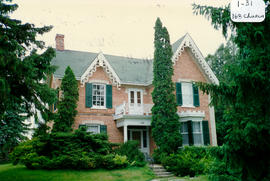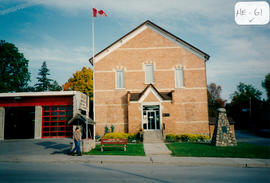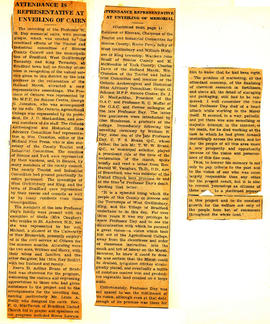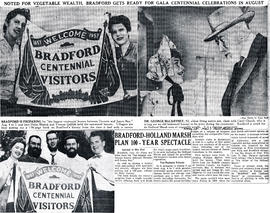Attendance is Representative at Unveiling of Cairn
The unveiling of the Professor W.H. Day memorial cairn, with bronze plaque, which was erected by the combined efforts of the Tourist and Industrial Committee of Simcoe County Council and the municipalities of Bradford, West Gwillimbury Township and King Township, at Bradford town hall on Sunday afternoon in recognition of the valued service given to this district by the late professor in the reclamation of the Holland Marsh, attracted a very representative assemblage. The Province of Ontario was represented by the M.P.P. for Simcoe Centre, George G. Johnston, who was accompanied by his wife. The Ontario Agricultural College was represented by its president, Dr. J.D. MacLachlan, and several members of its staff. The Ontario Archaeological and Historical Sites Advisory Committee had representation in Wm. Cranston, editor of the Midland Free Press, who is also secretary of the County Tourist and Industrial Committee. The counties of Simcoe and York were represented by their wardens, and in Simcoe, by many members of the county council. The county Tourist and Industrial Committee had present practically its entire personnel. The townships of West Gwillimbury and King, and the town of Bradford were represented by their reeves and councils as well as by many residents from these municipalities.
The members of the late Professor Day's family were present with the exception of Stella (Mrs. Caughey) who resides in St. Andrews, N.B., but she was represented by her son, Michael, a student at the University of New Brunswick, presently employed in the civil service at Ottawa for the summer months. Attending were the two sons, William and Harry with their wives and families and the other daughter, Ida (Mrs. Ray Smith) with her husband and family.
Reeve D. Arthur Evans of Bradford was chairman for the program, welcoming the visitors and expressing appreciation to those who had given assistance to the project and to the arrangements for the unveiling day, naming particularly Mr. Louis A. Neilly who designed the cairn. Rev. F.G. MacTavish of Bradford United Church led in prayer and speakers on the program included Reeve Lawson Robinson of Elmvale, Chairman of the Tourist and Industrial Committee for Simcoe County; Reeve Percy Selby of West Gwillimbury and William Hodgson of King Township; Wardens John Small of Simcoe County and M. McMeachie of York County; Charles Davis of the Holland Marsh; Wm. Cranston of the Tourist and Industrial Committee and member of the Ontario Archaeological and Historical Sites Advisory Committee; George G. Johnson, M.P.P., Simcoe Centre; Dr. J.D. MacLachlan, President of the O.A.C. and Professor R.C. Moffat of the O.A.C. and former colleague of the late Professor Day. The latter two gentlemen were introduced by Glen Henderson, a graduate of the college. Immediately following the unveiling ceremony by William N. Day, elder son of the late Professor Day, C.T.S. Evans, Q.C., whose father, the late T.W.W. Evans, Q.C., as municipal solicitor, played a prominent role at the time of the reclamation of the marsh, spoke briefly and read a letter from Rev. Harold W. Vaughan, Th.D., D.D. now of Brantford, who was minister of the United Church here previous to and at the time of Professor Day's death. Quoting that letter:
"It is a splendid thing which the people of this County of Simcoe and the Townships of West Gwillimbury, King and the Village of Bradford, undertake to do this day. For over three years it was my privilege to know Professor Day and to see the determination with which he pursued a great vision - a vision which took him out of the Agricultural College, away from the cleanliness and order of classroom instruction into the muck and toil of labour on the Marsh. However, he knew it could be done. He was certain that the Marsh could be drained, irrigation ditches strategically placed, and eventually a battle of moisture control won and productive vegetable land created on a large scale.
Unfortunately, Professor Day was not spared to see the fulfillment of his vision, although even at that date, enough of its promise was there for him to know that he had been right.
The problem of marketing of the attendant economy, of the finalizing of chemical research in fertilizers, and above all, the detail of storing and packaging, still had to be conquered. I well remember the time that Professor Day died of a heart attack while working in the Marsh itself. It seemed, in a way, pathetic and yet there was also something of majestic triumph in the manner of his death, for he died working at the task to which he had given himself unstintingly across the years, and today the people of all this area know a new prosperity and opportunity because of the vision and perseverance of this fine man.
Thus, to honour his memory is not only to pay tribute to the past and to the vision of one who was more largely responsible than any other for the present result, but it is also to commit yourselves as citizens of these areas to a continued interest in this project and to its consistent growth for the welfare not only of the people here but of consumers throughout the whole land."





